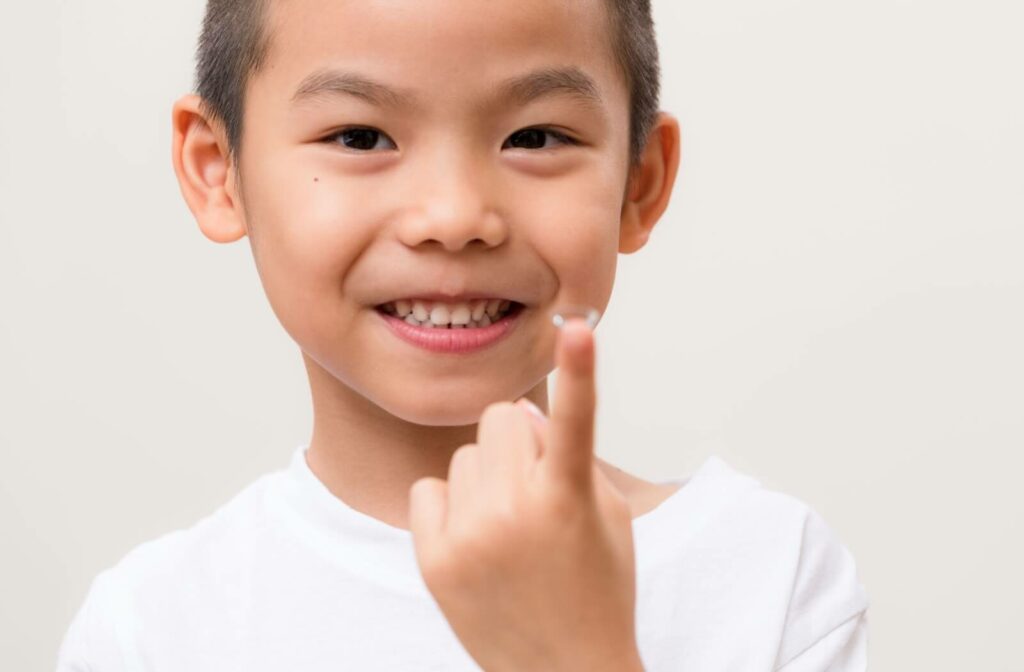Myopia is a common refractive error that usually develops during childhood. While it is not usually a severe condition, leaving it unmanaged can worsen the symptoms and increase your chances of developing serious eye conditions later in life.
Our eyes grow and develop throughout childhood and early adolescence. Myopia can worsen as we grow older; however, we can effectively slow its progression during this time of eye growth and development.
Understanding Myopia
Myopia, commonly known as nearsightedness, is a refractive error that causes distant objects to appear blurry while close objects can be seen clearly. Myopia can make tasks like seeing the board at school or driving difficult.
Myopia leads to blurry distance vision because the shape of the eye is affected. When light is refracted by the cornea and enters the lens, it focuses directly on the retina, allowing for clear vision.
The shape of an eye with myopia is elongated, affecting how light focuses on the retina. With myopia, light is focused in front of the retina instead of directly on it, resulting in blurry distance vision.
Recognizing the symptoms of myopia early can help in managing the condition. Common symptoms of uncorrected myopia include:
- Blurry vision when looking at distant objects
- Holding objects close to the eyes
- Squinting to see clearly
- Frequent headaches
- Eye strain or fatigue
- Headaches
Myopia Development
Myopia rates are increasing, particularly among children. While myopia can occur at any age, it most commonly develops in children aged 6 to 14. In the United States, around 5% of preschoolers and 9% of elementary school children are affected by this condition. In the United States, approximately 41.0% of children aged 5 to 17 in urban areas have myopia, with a nationwide prevalence estimated at 36.1%.
Myopia is believed to be influenced by a combination of genetic and environmental factors that impact the shape of the eye, leading to eye elongation. Factors that can influence myopia development can include:
- Having at least one parent with myopia
- Spending less time outdoors
- Spending extended periods doing prolonged close-up work (using electronic devices or reading)
During childhood, the eyes grow and change and this can occur rapidly, leading to frequent changes in vision prescriptions. Eye growth generally ends around age 20, at which point vision prescriptions tend to stabilize, making childhood and adolescence an important time for myopia management.
If untreated, myopia can worsen with age. The rate of progression can vary but is determined during comprehensive eye exams.
Can Myopia Improve With Age?
Many people believe that myopia can improve with age, but this is generally not the case.
While our eyes do change over time, myopia usually does not improve on its own. Some adults may notice a slight improvement in their vision between the ages of 40 and 50, but this is often related to the development of cataracts or presbyopia rather than an actual improvement in myopia.
Although myopia can’t be cured, it can be managed to slow its progression. These treatments aim to prevent further elongation of the eye.
The ideal time for starting myopia control treatments is during childhood, as children’s eyes are still growing and more susceptible to change. Myopia management can begin as early as age 4 but is most commonly started between ages 6 and 8.
Myopia control isn’t just for children; adults can also benefit, although the effectiveness may vary. Early intervention is key for ideal control.

Importance of Myopia Control
Myopia itself isn’t a severe eye condition, but leaving it unmanaged can lead to high myopia, which puts individuals at an increased risk of developing serious eye conditions that can lead to vision loss.
To avoid worsening myopia and its associated risks, myopia control treatments are available to help slow eye elongation, slow its progression, and maintain eye health.
Treatments for Myopia Control
Several myopia control options have been shown to slow myopia progression in children effectively. Your optometrist will determine the most suitable treatment option and its duration.
Low-dose Atropine Drops
Low-dose atropine drops contain a medication that dilates the pupil, relaxing the eye and allowing for reduced accommodation or focusing. These drops are applied to both eyes once a day before bedtime to minimize the side effects of blurry vision and light sensitivity that can be experienced during the day.
Your optometrist will determine the duration of this treatment, which can last several years. While on atropine, regular follow-up appointments are important to monitor progress and adjust the dosage of drops as needed.
Even though research shows that low-dose atropine drops can slow myopia progression in children aged 4 to 16, there often is a rebound effect; that is some of the myopia can return upon discontinuation.
Orthokeratology Lenses
Orthokeratology (ortho-k) lenses are specially designed gas permeable contact lenses intended for overnight wear. When worn during sleep, these lenses can temporarily reshape the cornea, allowing for clear vision throughout the day.
By altering the shape of the cornea, ortho-k lenses can reduce refractive error, allowing light to focus directly on the retina. Some research indicates that when peripheral light rays are focused in front of the retina, the elongation of the eye is slowed, acting as a signal to halt further eye growth.
Research shows that ortho-k lenses can effectively slow myopia progression in young adults up to age 29, although it is a very small amount of evidence without the same strength or volume as for children.
Bifocal and Single Vision Eyeglasses
Bifocal eyeglasses are lenses that have distinct optical powers, one for viewing distance objects and another for close-up tasks. This dual optical design can affect peripheral focus, helping to minimize eye elongation in very specific cases. As of this writing, single vision spectacle lenses to control myopia are not yet available in the U.S.
Schedule an Appointment
Myopia is a common eye condition affecting children, but leaving it unmanaged can worsen myopia, increasing the chances of developing severe eye conditions.
While myopia can’t be cured, it can be managed with myopia control treatments. Connect with our team at Pompton Eye & Vision Care to schedule an appointment.



